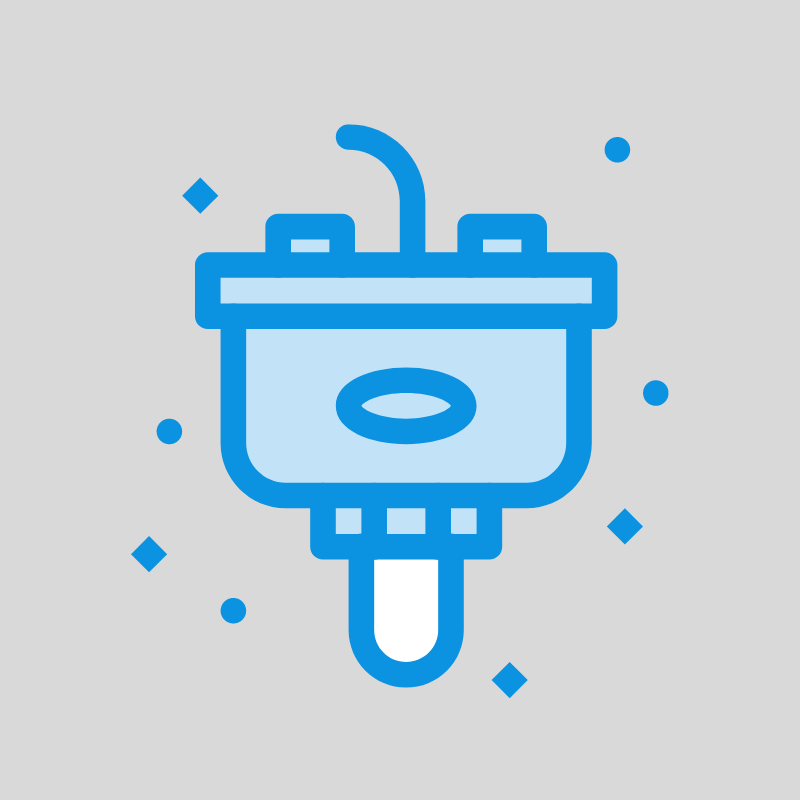Garbage disposals have been around for more than 100 years, but surprisingly, less than half of the homes in the US have a garbage disposal. They make quick work out of post-meal cleanup, and they add to the cleanliness of your kitchen, so it is an appliance worth installing.
In this article, we will explain how garbage disposals operate and their many benefits. We will educate you on the rules of using a disposal to maximize its lifespan and learn how installing one can save you money by reducing service calls and protecting your plumbing system. Lastly, we will include information on keeping your disposal in great shape and how to perform minor repairs should a problem occur.
How They Work
Garbage disposals are simple appliances used to pulverize food so it can more easily flow through your drainage system and out to the public sewer or private septic tank.
Garbage disposals mainly run on electricity, so a power source near the sink is required. A disposal has a holding tank or hopper under the sink, which sits below the drain opening. Inside are two impellers or rotors that use centrifugal force to push the food scraps you insert into the drain and push them to the outer ring.
The ring is where the food particles are ground up to as close to a liquid form as possible and then sent down the drain. Modern disposals are designed to accept larger pieces of food, but if yours is older, cutting the waste into smaller bits can help.
The impellers move rapidly at approximately 2800 revolutions per minute, depending on the model you install. This high rate of pulverization makes it easy for food bits to easily travel through the drainage system with ease. However, homes with older plumbing are prone to rust and corrosion, leaving the pipe’s interior rough catching small bits that eventually lead to clogs. Newer plastic plumbing pipe types have smooth interiors and are corrosion-resistant, so this issue is greatly reduced.
Benefits Of A Garbage Disposal
In addition to quick cleanups and a cleaner kitchen, garbage disposals offer homeowners, and the environment, several other benefits worth mentioning.
Odor Reduction
When the disposal removes food scraps, they are quickly moved out of your kitchen and into the sewer, never to be thought of again. But, if you choose not to install one, all kitchen waste ends up in the trash can. Decomposing food emits a foul odor which is unpleasant and may attract rodents and other animals in search of food. Rid yourself of nasty kitchen odors from rotting food by installing a garbage disposal.
Saves Money
First, you will need to purchase fewer garbage bags by using a disposal, and over time that can add up to substantial savings.
Additionally, since food waste glides easily through plumbing pipes, there are fewer issues with clogs and leaking pipes, so the need to call for service on your plumbing system is greatly reduced.
Environmental Factors
When food waste is eliminated at home, the amount of material going to the local landfill is reduced. Decaying waste produces methane gas which is a powerful and destructive greenhouse gas responsible for 30% of the rise in global temperatures.
Methane gas is also a contributor to air, water, and soil contamination and drives extreme heat and weather events such as wildfires and flooding. The Environmental Protection Agency is working toward mitigating the harmful effects of methane gas.
Follow These Rules
Operating your garbage disposal and providing appropriate maintenance are easily accomplished once you understand what habits you need to develop. Here we will explain how to maintain your disposal to maximize its lifespan.
Keep These Items Out
In the past there were strict rules about what was permitted to be disposed of in the garbage disposal but new technology has made them more durable and able to grind up most food scraps. Here is a list of 3 items that still should be avoided followed by a list for those with an older appliance.
Fats, oils, and grease should never be put down a drain. The liquid solidifies and coats the interior lining of plumbing pipes, making them sticky and more apt to attract and hold food particles. This eventually leads to clogged pipes and frequent service calls.
For those with older disposals do not put fibrous foods such as celery, starchy foods, egg shells, coffee grounds, or hard items like bones or fruit pits into the disposal. These can jamb the impellers or expand inside the drain pipe blocking the flow of wastewater.
Remember To Do These Things
Always run your garbage disposal at the end of every day. Prior to turning it on allow cold water to run for 10 seconds and continue running the water while the grinding is occurring. Follow up by another 10 seconds of running water once the unit is turned off.
Regular Cleaning
The hopper may be cleaned with a stiff brush and dish soap once a week. Be certain to clean underneath the rubber gasket where food bits like to sit.
Monthly cleaning of the disposal should be done by freezing vinegar in ice cube trays and putting six in the hopper along with a half cup of baking soda. Turning on the unit will allow the ice to sharpen the impellers and refresh the drain pipe.
If the disposal emits a bad odor you can pulverize the peels of any citrus fruit such as lemons and limes to rid yourself of lingering odors.
Minor Repairs
From time to time your garbage disposal may turn itself off or become inoperable. Here are two steps you can take to try and revive the disposal.
Reset
Underneath the sink is where the garbage disposal sits and if you look closely you will see a red reset button. If your disposal shuts itself off you should always try to reset it. This often solves any issues but if it does not you need to call for professional help.
Jams
Before we discuss jamming it is important to note. Under no circumstances should you ever put your fingers in the disposal even if the unit is turned off. A stuck food item may disengage and the impellers can severely damage your fingers.
If the unit is receiving power but the impellers are jammed you should turn the unit off and grab the tool that was provided when you purchased the unit.
Insert the key into the slot on the underside of the unit and move it back and forth. This should free up blockages and allow your impellers to return to do their job.
Looking For Garbage Disposal Installation And Repair?
We offer garbage disposal installation and repair and recommend you add a garbage disposal to your array of kitchen devices. Not only will a disposal help keep your kitchen sanitary, it will provide relief to the environment and reduce the greenhouse gases being released by landfills.
Proper use and minor maintenance will keep your disposal in great shape but if you experience issues beyond those discussed in this article we advise you to give us a call. We are professional plumbers trained, licensed, and insured to make certain your garbage disposal is providing optimal service to make your home as comfortable and as safe as possible. Give us a call today!

